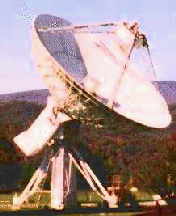 Orbiting VLBI Tracking Station
Orbiting VLBI Tracking Station
Tracking Station Mission
The Orbiting VLBI tracking station in Green
Bank, West Virginia is one of four NASA tracking stations dedicated
to support of Very Long Baseline Interferometry satellites. Current and
future satellites extend interferometry baselines beyond the diameter of
the earth. The trackings stations transmit a maser referenced timing tone
to the orbiting satellites. The satellites sample the astronomical signals
and transmit the data on a Ku band downlink back to the stations. The tracking
stations record the data on wideband magnetic tape and ship it to correlators
for further processing. The Observatory and tracking station are located
in a valley at elevation 2750' ,
and are shielded from radio interference by mountains to the east
and west. For additional views of the tracking
station, click here, or here.
Space VLBI satellites
VSOP/HALCA
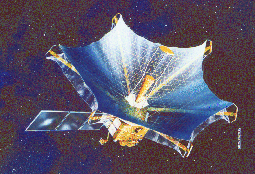 The Japanese Space agency, ISAS ,
launched
VSOP/HALCA on 97 February 12. VSOP/HALCA
has a home page. The VSOP/HALCA mission operations group maintains
an
interface document
page.
The Japanese Space agency, ISAS ,
launched
VSOP/HALCA on 97 February 12. VSOP/HALCA
has a home page. The VSOP/HALCA mission operations group maintains
an
interface document
page.
RadioAstron
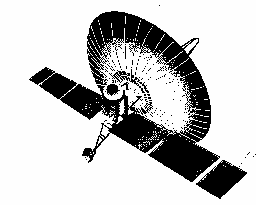 The Russian
Space agency is building a Radio telescope,
RadioAstron
, as a part of the spectrum series. RadioAstron is scheduled to be
launched after the gamma ray satellite, Spectrum X-Gamma.
Recent RadioAstron compatibility tests on
99 May 23-28 are described in some detail.
The Russian
Space agency is building a Radio telescope,
RadioAstron
, as a part of the spectrum series. RadioAstron is scheduled to be
launched after the gamma ray satellite, Spectrum X-Gamma.
Recent RadioAstron compatibility tests on
99 May 23-28 are described in some detail.
ARISE
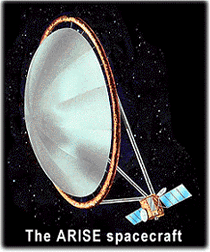 Researchers at JPL and
their colaborators are planning a next generation space radio telescope,
ARISE,
Advanced Radio Interferometry between Space and Earth.
Researchers at JPL and
their colaborators are planning a next generation space radio telescope,
ARISE,
Advanced Radio Interferometry between Space and Earth.
OVLBI Online Documentation
The OVLBI Memo Series contains detailed description of tracking station
design considerations. Some memos describe the mathmatical considerations
leading to development of station hardware and software. Hardware design
documents describe constraints and design specifications. Other hardware
memos describe testing of modules during development. The software documents
describe the design and testing of the software.
A description of the format of data provided to the VSOG for calibrating
data and locating it on the VLBA tapes is available
.
The International Mission Operations Group agreements are documented
in a
memo
series kept at JPL.
The software guide describes the offline and realtime programs which control
the tracking station. The guide describes the station inputs and outputs
and the methode for transfering files to other mission elements.
The hardware guide describes the major OVLBI hardware modules and sub-assemblies.
The Green Bank tracking station updates an ASCII
status
summary of the tracking station activites every 5 minutes. The summary
lists the current direction the antenna is pointing, the current activity,
wideband data recording status, two way link status and any anomalous hardware
states.
The Green Bank tracking station uses the MIT Near Real Time Correllator
to regularly generate autocorrellation spectra from the HALCA downlink
data. The spectra are updated every 10 minutes.
For the VLBI observations using the Green Bank Earth Station, the experiment
and the link stability is shown on a pass by pass basis. Plots of the difference
between predicted and measured down link frequency show the quality of
the orbit prediction. The plots of the RMS during two second fits to the
down link phase residuals measure the stability of the link.
A history of tracking passes performed at Green Bank is given.
The Earth Station Milestones:
The first high resolution image from HALCA is shown below right. The image
on the left is the ground-only image of the radio source. Notice the much
improved angular resolution image made using HALCA data.
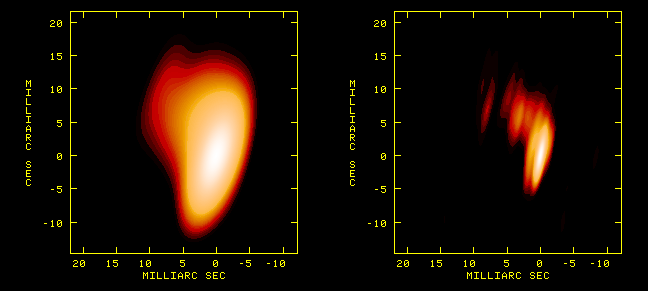
The two images above are of an extreamly high energy jet of particles
ejected from the center of the distant blazar 1156+295. The bright white
component in the center of the image is due to material falling onto a
giant black hole at the center of the object. Magnetic fields surrounding
the black hole accellerate the particles into a narrow jet.
97 May 22: HALCA First Fringes with NRAO VLBA
The alignment in time of astronomical signal from HALCA throught the Green
Bank Earth Station and the NRAO VLBA antennas. The radio source 1519-273
was observed at L-Band.
97 May 20: HALCA First Fringes with NRAO 140ft
The first alignment in time of astronomical signal from HALCA throught
the Green Bank Earth Station and the NRAO 140ft telescope in Green Bank,
WV. The radio source 1519-273 was observed at L-Band
97 April 1+2: VSOP/HALCA First Observations simultaneously with VLBA
The first tracking station data recordings made simultaneously with the
VLBA were made at L-Band (1.6 GHz). The strong radio source 1334-127 was
observed.
97 March 21: First successful VSOP/HALCA Tracking
The tracking station locked to the Ku band down link from VSOP/HALCA. The
decoded VSOP/HALCA telemetry data indicated that VSOP/HALCA was successfully
locked to the tracking station uplink tone.
96 October: Doppler Data Exchange
Measurement of the range rate to the Surfsat transponder. A number of software
problems were solved and orbit predictions for Surfsat based only on Green
Bank data were created at JPL.
97 September 12: Surfsat C Band VLBI
The Surfsat VLBI experiment was repeated successfully (see below), but
at a higher frequency. At higher frequencies the stability of the space
to ground link is more throughly tested.
96 May: Surfsat S Band VLBI
In collaboration with the NRAO VLBA and Engineers at JPL, the first Surfsat
VLBI experiment was performed in 96 May. In this test, the NRAO GB 140'
Telescope was used in its normal VLBI mode, but with the maser timing reference
signal being transmitted the Surfsat Transponder. The timing tone was successfully
recieved at the Tracking station, modulated onto optical fiber and provide
to the 140' telescope as the timing reference. Simulatenously, the time
corrections data were collected at the tracking station and provided to
the VLBA correlator. The VLBA correlator used the timing data to allow
successful correlation of the observations with VLBA antennas.
96 March: VSOP Compatability Tests
The Japanese Satellite Sampler,Formatter and Communications model was brought
to Green Bank for Compatability Tests. After minor adjustments, the data
communications between the tracking station and satellite simulator were
found to be compatable.
95 November 5: Tracking Surfsat
The NASA/JPL orbiting test transponder, Surfsat, was first tracked by the
Green Bank Earth Station. A two-way link to Surfsat was first established
on 95 Dec 15.
95: Tracking Geotail
The Japanese space agency satellite GEOTAIL has been tracked by the Green
Bank Tracking Station. This test validated the orbital predition interface
to NASA/JPL/DSN.
94: First Light
First dual 8.4 and 14.4 GHz
observations
of radio sources.
Astronomy with the Tracking Station Antenna
X and Ku Band Surveys
The Green Bank Earth Station is conducting an all Northern Sky Survey at
both X and Ku band. This survey program is intended
to map the entire Norther sky simultaneously at 8.35 and 14.35 GHz at regular
intervals.
A North pole Transient Source Search has recently
been completed by Julie Zuber.
X and Ku Band Gamma Ray Burst Monitoring
Dail Frail at the AOC notified Green Bank of a Gamma Ray Repeater
in the vacinity of the galactic center. This region has been mapped
by the GBES, and an uncalibrated FITS Image
is available.
Other Web Sites
VLBA Correlator
NRAO Socorro is
developing other hardware and software for the NASA OVLBI project. The
latest
experiment summaries and
fring plots from the correllator are also available.
DRAO Correlator
The Canadian Space Agency Supports both the Russian RadioAstron and Japanese
HALCA mission with the
S2
Correlator at DRAO .
JPL/DSN
JPL has a
Space
Very Long Baseline Interferometry Project home page.
Ground Observatories
The National Radio Astronomy Observatory
(NRAO)
is a facillity of the National Science Foundation
operated under cooperative agreement by Associated Universities, Inc.
JPL maintains a summary of
recent tests .
tminter@nrao.edu
Last update: 99 May 28
 Orbiting VLBI Tracking Station
Orbiting VLBI Tracking Station Orbiting VLBI Tracking Station
Orbiting VLBI Tracking Station The Japanese Space agency, ISAS ,
launched
VSOP/HALCA on 97 February 12. VSOP/HALCA
has a home page. The VSOP/HALCA mission operations group maintains
an
interface document
page.
The Japanese Space agency, ISAS ,
launched
VSOP/HALCA on 97 February 12. VSOP/HALCA
has a home page. The VSOP/HALCA mission operations group maintains
an
interface document
page.
 The Russian
Space agency is building a Radio telescope,
RadioAstron
, as a part of the spectrum series. RadioAstron is scheduled to be
launched after the gamma ray satellite, Spectrum X-Gamma.
Recent RadioAstron compatibility tests on
99 May 23-28 are described in some detail.
The Russian
Space agency is building a Radio telescope,
RadioAstron
, as a part of the spectrum series. RadioAstron is scheduled to be
launched after the gamma ray satellite, Spectrum X-Gamma.
Recent RadioAstron compatibility tests on
99 May 23-28 are described in some detail.
 Researchers at JPL and
their colaborators are planning a next generation space radio telescope,
ARISE,
Advanced Radio Interferometry between Space and Earth.
Researchers at JPL and
their colaborators are planning a next generation space radio telescope,
ARISE,
Advanced Radio Interferometry between Space and Earth.
